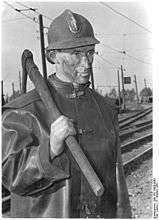Miner
|
| |
| Occupation | |
|---|---|
Occupation type | Manual labour |
Activity sectors | Mining |
| Description | |

A miner is a person who extracts ore, coal, or other minerals from the earth through mining. There are two senses in which the term is used. In its narrowest sense, a miner is someone who works at the rock face; cutting, blasting, or otherwise working and removing the rock.[1][2] In a broader sense, a "miner" is anyone working within a mine, not just a worker at the rock face.[1] This article will consider this broader concept.
In regions with a long mining tradition, many communities have developed cultural traditions and aspects specific to the various regions, in the forms of particular equipment, symbolism, music, and the like.
Roles
Different ications of the individual miner. Many of the roles are specific to a type of mining, such as coal mining. Roles considered to be "miners" in the narrower sense have included:
- Hewer (also known as "breaker" or "pickman"), whose job was to hew the rock.
- Collier, a hewer who hews coal with a pick.
- Driller, who works a rock drill to bore holes for placing dynamite or other explosives.
Other roles within mines that did not involve breaking rock (and thus fit the broader definition) have included:
- Loader (also called a "bandsman"), who loads the mining carts with coal at the face.
- Putter (also known as a "drags-man"), who works the carts around the mine.
- Barrow-man, who transported the broken coal from the face in wheelbarrows.
- Hurrier, who transported coal carts from a mine to the surface.
- Timberer, who fashions and installs timber supports to support the walls and ceiling in an underground mine.
In addition to miners working underground, a mine employs other workers in duties at the surface. In addition to office staff of various sorts, these may include:
- Brakesman, who operate the winding engine.
- Breaker boy who breaks coal.
Modern miners
Miner employment is expected to grow at an average rate as other jobs.[3]
The basics of mining includes finding, extracting, and preparing minerals, metals and coal. These products are used by utilities and manufacturing industries. Miners also supervise the construction of underground mine operations and create ways to transport the extracted minerals to processing plants.[3]
Miners use the principles of math and science to develop economical solutions to technical problems. They often work on new products considering a variety of factors and evaluate a final design for cost, safety, effectiveness, and reliability. In addition, miners are required to work in production, maintenance, and testing. Nanotechnology is a new aspect being introduced into mining.[3]
In most cases, a bachelor's degree in engineering, mining engineering or geological engineering is required. Jobs requiring research often require a degree in engineering. Because technology is constantly changing, miners need to continue their education.[3]
Mining is one of the most dangerous trades in the world.[4] in some countries, miners lack social guarantees and in case of injury may be left to cope without assistance.
Gallery
-

A brown coal miner with a pickaxe. West Germany, 1952
-
.jpg)
Miner in a mine of the "Cerro Rico" at Potosí, Bolivia, 2006
-

Miner spraying rockdust in a mine in West Virginia, 2009
See also
- Underground mining (hard rock)
- Miner's apron
- Miner's cap
- Miner's habit
- Mining helmet
- Mooskappe, miner's cap worn in the Harz
References
| Wikimedia Commons has media related to Miners. |
- 1 2 Hill, Albert H. (1920). "miner". A Glossary of the Mining and Mineral Industry. Washington D.C.: United States Department of the Interior, Bureau of Mines.
- ↑ Raymond, R.W. (1881). "miner". A Glossary of Mining and Metallurgical Terms. Easton, Pa.: American Institute of Mining Engineers.
- 1 2 3 4 "Career Information: Mining and Geological Engineers". Campus Explorer. Retrieved 11 February 2013.
- ↑ http://abcnews.go.com/WN/mining-dangerous-job/story?id=10301377
